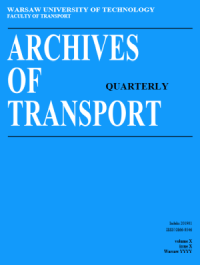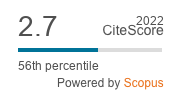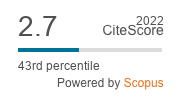Research on the effectiveness of alternative propulsion sources in high-tonnage cargo transport
DOI:
https://doi.org/10.5604/01.3001.0015.6934Keywords:
high-tonnage cargo transport, LNG, transport costs, alternative propulsion sources, pro-ecological solutionAbstract
The progressive degradation of the environment makes implementing pro-ecological solutions in various areas of our lives more meaningful. These measures also apply to transport, responsible for around 30% of total carbon dioxide emissions in the EU. Implementing ecological solutions in road transport encounters various barriers resulting mainly from the specificity of transport tasks. One of the most promising solutions in the high-tonnage road transport sector seems to be LNG-fueled engines, which allow for similar operating conditions to traditional combustion vehicles. The article aims to identify the environmental benefits of the use of high-tonnage LNG-fueled vehicles in freight transport and to conduct a comprehensive assessment of the economic efficiency of this solution. The article assesses the effectiveness of using an LNG-fueled vehicle and a diesel-fueled vehicle that meets the highest exhaust emission standard in high-tonnage transport, both in terms of economy and an impact of these solutions on the environment. The research was carried out on a given route, taking into account variants of vehicle manning and simulations of transport cycle time. In conclusion, a discussion of the obtained results was carried out, emphasizing the factors determining the profitability of using high-tonnage vehicles with LNG drive or its lack. Regardless of the indicated lack of clarity in the economic assessment of the effectiveness of LNG drives in high-tonnage vehicles, the identified environmental benefits from implementing these solutions seem to be quite unequivocal. Thus, it should be expected that in the event of loss of economic competitiveness of these solutions, appropriate fiscal instruments should be used - especially since LNG drives in the policies of individual countries are considered pro-ecological solutions.
References
Ambroziak, T., Jachimowski, R., Pyza, D., Szczepański, E. (2014). Analysis of the traffic stream distribution in terms of identification of areas with the highest exhaust pollution. Archives of Transport, 32(4), 7–16.
BFStrMG, (2011). Gesetz über die Erhebung von streckenbezogenen Gebühren für die Benutzung von Bundesautobahnen und Bundesstraßen (Bundesfernstraßenmautgesetz - BFStrMG), 12.07.2011.
Carter, C.R., Rogers, D.S. (2008). A framework of sustainable supply chain management: Moving toward new theory. International Journal of Physical Distribution & Logistics Management, 38(5), 360–387.
Cornelis, S. (2019). Do gas trucks reduce emissions? Transport & Environment, European Federation for Transport and Environment AISBL (https://www.transportenvironment.org/discover/do-gas-trucks-reduce-emissions/).
Dasgupta, S., Lall, S., Wheeler, D. (2021). Spatiotemporal analysis of traffic congestion, air pollution, and exposure vulnerability in Tanzania. Science of The Total Environment, 778, 147114.
Demir, E., Bektaş, T., Laporte, G. (2014). A re-view of recent research on green road freight transportation. European Journal of Operational Research, 237(3), 775-793.
Drake, D., Spinler, S. (2013). Sustainable operations management: An enduring stream, or passing fancy? Working paper 13-084. Harvard Business School.
Elkington, J. (2004). Enter The Triple Bottom Line. In Henriques, A., Richardson, J. (Eds.). The triple bottom line: Does it all add up? London: Earthscan. 1–16.
Ellingsen, L.A.W., Singh, B., Strømman, A.H. (2016). The size and range effect: Lifecycle greenhouse gas emissions of electric vehicles. Environmental Research Letters, 11(5), 054010.
Izdebski, M., Jacyna, M. (2018). The Organization of Municipal Waste Collection: the Decision Model. Rocznik Ochrona Środowiska, 20(1), 919–933.
Jacyna, M, Semenov, I., (2020). Models of vehicle service system supply under information uncertainty. Eksploatacja i Niezawodność – Maintenance and Reliability, 22(4), 694–704.
Jacyna, M., Merkisz, J., (2014). Pro-ecological approach to modelling traffic organization in national transport system. Archives of Transport, 30(2), 31–41.
Jacyna, M., Wasiak, M., Lewczuk, K., Chamier-Gliszczyński, N., Dąbrowski, T. (2018). Decision problems in developing proecological transport system. Rocznik Ochrona Środowiska, 20(1), 1007 – 1025.
Jacyna, M., Wasiak, M., Lewczuk, K., Karoń, G. (2017). Noise and environmental pollution from transport: decisive problems in developing ecologically efficient transport systems. Journal of Vibroengineering, 19(7), 5639-5655,
Jacyna, M., Wasiak, M., Lewczuk, K., Kłodawski, M. (2014). Simulation model of transport system of Poland as a tool for developing sustainable transport. Archives of Transport, 31(3), 23–35.
Jacyna, M., Zochowska, R., Sobota, A., Wasiak, M. (2021). Scenario Analyses of Exhaust Emissions Reduction through the Introduction of Electric Vehicles into the City. Energies, 14(7), 2030.
Jacyna, M., Wasiak, M. (2015). Multicriteria Decision Support in Designing Transport Sysems. In Mikulski, J. (ed.), Tools of Transport Telematics, Springer.
Jacyna-Gołda, I, Izdebski, M., Szczepański, E., Gołda, P., 2018. The assessment of supply chain effectiveness. Archives of Transport, 45(1), 43-52.
Keller, M., Hausberger, S., Matzer, C., Wüthrich, P., Notter, B. (2017). HBEFA Version 3.3. Background documentation, Berne, 12.
Kholod, N., Evans, M., Gusev, E., Yu, S., Malyshev, V., Tretyakova, S., Barinov, A. (2016). A methodology for calculating transport emissions in cities with limited traffic data: Case study of diesel particulates and black carbon emissions in Murmansk. Science of The Total Environment, 547(11),305-313.
Kollamthodi, S., Norris, J., Dun, C., Brannigan, Ch., Twisse, F., Biedka, M., Bates, J. (2016). The role of natural gas and biomethane in the transport sector. Final Report, Ricardo Energy&Environment. Number 1.
Leleń, P., Wasiak, M. (2019). The model of selecting multimodal technologies for the transport of perishable products. Archives of Transport, 50(2), 17–33.
Lewczuk K., Wasiak M. (2011). Transportation services costs allocation for the delivery system. Proceedings - ICSEng 2011: International Conference on Systems Engineering Pages 429 - 4332011 Article number 604187421st International Conference on Systems Engineering, ICSEng 2011, Las Vegas, NV, 16 August 2011 - 18 August 2011, 87119.
Mckinnon, A. (2003). The effects of transport investment on logistical efficiency. Edinburgh: Heriot-Watt University, Logistics Research Centre. http://www.sml.hw.ac.
Mirhedayatian, S.M., Yan, S.A. (2018). Framework to evaluate policy options for supporting electric vehicles in urban freight transport. Transportation research part D: transport and environment, 58, 22–38.
Nam, E.K., Giannelli, R. (2005). Fuel consumption modeling of conventional and advanced technology vehicles in the physical emission rate estimator (PERE). Draft Report No. EPA420-P-05-001, U.S. Environmental Protection Agency, Washington, DC, USA.
Ntziachristos, L., Samaras, Z. (2017). EMEP/EEA air pollutant emission inventory guidebook, EEA.
Rakha, H.A., Ahn, K., Moran, K., Saerens, B., Van Den Bulck, E. (2011). Virginia tech comprehensive power-based fuel consumption model: model development and testing. Transportation Research Part D: Transport and Environment, 16(7), 492–503.
Ramacher, M.O.P., Matthias, V., Aulinger, A., Quante, M., Bieser, J., Karl, M. (2020). Contributions of traffic and shipping emissions to city-scale NOx and PM2.5 exposure in Hamburg. Atmospheric Environment, 237, 117674.
Regulation 561/2006. Driving time and rest periods in the road transport sector. Regulations of the European Parliament and of the Council of 15 March 2006.
Report (2017). Test report of Iveco LNG-powered HD-truck, Unilever, Link Transport, Iveco, Cryogas M&T Poland, 20.06.2017 – 15.07.2017.
RP (1974). Labor Code Act, Ustawa z dnia 26 czerwca 1974 r. Kodeks pracy (Dz. U. 1974 Nr 24 poz. 141, ze zm.)
RP (2004). Act on the working time of drivers, Ustawa z dnia 16 kwietnia 2004 r. o czasie pracy kierowców (Dz. U. 2004 Nr 92 poz. 879, ze zm.).
Scora, G., Barth, M. (2006). Comprehensive modal emissions model (cmem), version 3.01. User guide. Centre for Environmental Research and Technology. University of California, Riverside, 1070.
Song, H., Ou, X., Yuan, J., Yu, M., Wang, Ch., (2017). Energy consumption and greenhouse gas emissions of diesel/LNG heavy-duty vehicle fleets in China based on a bottom-up model analysis. Energy, 140(1), 966–978.
Szczepański, E., Jachimowski, R., Izdebski, M., Jacyna-Gołda, I. (2019). Warehouse location problem in supply chain designing: a simulation analysis. Archives of Transport, 50(2), 101-110.
Szczepański, E., Żak, J., Jacyna-Gołda, I., & Murawski, J. (2017). Simulation support of freight delivery schedule in urban areas. Procedia Engineering, 187, 520-525.
Tischer, V., Fountas, G., Polette, M., Rye, T. (2019). Environmental and economic assess-ment of traffic-related air pollution using aggregate spatial information: A case study of Balneário Camboriú, Brazil. Journal of Transport & Health, 14, 100592.
Tu, X., Yang, Y., Xu, J., Chen, Y. (2013). Evaluation of Difference between LNG and Diesel Heavy-duty Commercial Vehicle's Life Cycle Environmental Emission. China Mechanical Engineering, 24(11), 1525–1530.
Visvikis, C., Morgan, P., Boulter, P., Hardy, B., Robinson, B., Edwards, M., Dodd, M., Pitcher, M. (2010). Electric vehicles: review of type-approval legislation and potential risks. Transport Research Laboratory.
Wasiak, M., Jacyna, M. (2015). Model of Transport Costs in the function of the Road Vehicles Structure, Proceedings of the 20th International Scientific Conference Transport Means 2015, 5, 669-677.
Wasiak, M., Niculescu, A.I., Kowalski, M. (2020). A generalized method for assessing emissions from road and air transport on the example of Warsaw Chopin Airport. Archives of Civil Engineering, 66(2), 399–419.
Wasiak, M., Jacyna-Gołda, I. (2016). Transport drogowy w łańcuchu dostaw. Wyznaczanie kosztów. Wydawnictwo Naukowe PWN SA.
Wolfram, P., Wiedmann, T. (2017). Electrifying Australian transport: Hybrid life cycle analysis of a transition to electric light-duty vehicles and renewable electricity. Engineering, Applied Energy, 206, 531–540.
Zhao, Q, Huang, W, Hu, M, Xu, X, Wu, W. (2021). Characterizing the Economic and Environmental Benefits of LNG Heavy-Duty Trucks: A Case Study in Shenzhen, China. Sustainability, 13(24), 13522.
Downloads
Published
Issue
Section
License
Copyright (c) 2024 Archives of Transport journal allows the author(s) to hold the copyright without restrictions.

This work is licensed under a Creative Commons Attribution 4.0 International License.











